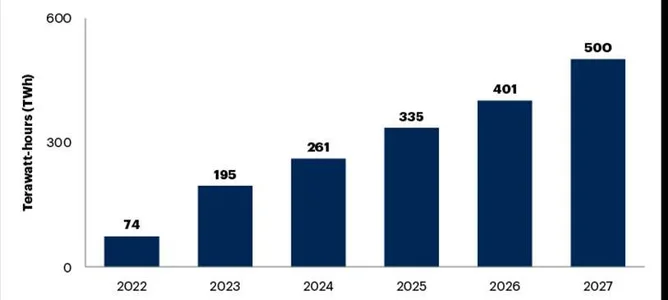According to Gartner, power shortages will restrict 40% of AI data centres by 2027, suggesting Gen AI energy consumption will exceed power utility capacity.
AI and generative AI (Gen AI) continue to drive rapid increases in electricity consumption, inevitably putting larger pressures on data centres to deliver.
New predictions from Gartner suggest that such rapid growth in data centre energy consumption to accommodate Gen AI will exceed the capacity of power utilities. The organisation suggests that data centre forecasts over the next two years could reach as high as 160% growth.
“The explosive growth of new hyperscale data centres to implement Gen AI is creating an insatiable demand for power that will exceed the ability of utility providers to expand their capacity fast enough.” – Bob Johnson, VP Analyst at Gartner.
Likewise, Gartner suggests that 40% of existing AI data centres will be operationally constrained by power availability by 2027.
AI has been cited as the critical cause of such a power surge in the data centre sector. Given that the technology consumes significant levels of power and energy in order to run, it is expected that power demands will continue to rise as a result, putting strain on the grid.
Confronting the rise of AI
Gartner estimates the power required for data centres to run incremental AI-optimised servers will reach 500 terawatt-hours (TWh) per year in 2027, which is 2.6 times the level in 2023 as evidenced below.
“The explosive growth of new hyperscale data centres to implement Gen AI is creating an insatiable demand for power that will exceed the ability of utility providers to expand their capacity fast enough,” says Bob Johnson, VP Analyst at Gartner. “In turn, this threatens to disrupt energy availability and lead to shortages, which will limit the growth of new data centres for GenAI and other uses from 2026.”

He adds: “New larger data centres are being planned to handle the huge amounts of data needed to train and implement the rapidly expanding large language models (LLMs) that underpin GenAI applications.
“However, short-term power shortages are likely to continue for years as new power transmission, distribution and generation capacity could take years to come online and won’t alleviate current problems.”
Data centres already account for roughly 1-1.5% of the total global electricity consumption in 2022, ahead of AI interest spiking. The International Energy Agency (IEA) has indicated in 2024 already that global electricity demand could double by 2026, suggesting an urgent need for data centres to confront their energy usage.
Such an overwhelming demand for AI could also lead to carbon dioxide (CO2) emissions from data centres increasing over the next decade. As a result, data centres must ensure they are harnessing AI in a way that doesn’t threaten their sustainability targets.
In the near future, Gartner suggests that the number of new data centres and the growth of Gen AI will be governed by the availability of power to run them. In response, Gartner recommends organisations determine the risks potential power shortages will have on all products and services.
Inevitably, power shortages will lead to an increase in the price of power – which Gartner says will also increase the costs of operating LLMs.
“Significant power users are working with major producers to secure long-term guaranteed sources of power independent of other grid demands,” Bob explains. “In the meantime, the cost of power to operate data centres will increase significantly as operators use economic leverage to secure needed power. These costs will be passed on to AI/Gen AI product and service providers as well.”
Evaluating future plans to save sustainability goals
Data centres require 24/7 power availability, with Gartner noting that renewable sources of power like wind or solar cannot provide without a form of alternative supply.
The firm suggests that reliable 24/7 power can only be generated by either hydroelectric, fossil fuel or nuclear power plants. Therefore, in response to rising emissions, Gartner suggests that businesses must evaluate future plans and anticipate higher power costs.
Many Companies Will Not Meet Their Net Zero Goals, NTT Finds
This is in conjunction with negotiating long-term contracts for data centre services at reasonable rates for power, the organisation explains.
Likewise, Gartner notes that businesses should be factoring in significant cost increases when developing plans for new products and services, whilst also looking for alternative approaches to innovation that require less power.
Through its research, Gartner has indicated that zero-carbon sustainability goals will be negatively affected by short-term solutions to provide more power. As surging demand is forcing suppliers to increase production, some have kept fossil fuel plants that had been scheduled for retirement in operation beyond their scheduled shutdown.
The company recommends organisations re-evaluate sustainability goals relating to CO2 emissions in light of future data centre requirements and power sources for the next few years.
When developing Gen AI applications, Gartner suggests that operators should focus on using a minimum amount of computing power and look at the viability of other options such as edge computing and smaller language models.
“The reality is that increased data centre use will lead to increased CO2 emissions to generate the needed power in the short-term,” Bob says. “This, in turn, will make it more difficult for data centre operators and their customers to meet aggressive sustainability goals relating to CO2 emissions.”



